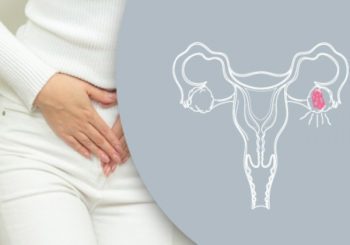Guest Writer for Wake Up World
Ovarian cancer doesn’t get as much airplay as other more common forms of reproductive cancer, like breast and prostate; only about 3 percent of all cancers in women start in the ovaries. Still, 20,000 women each year are diagnosed in the United States alone, and the prognosis can be scary. Ovarian cancer is called the “silent killer” by conventional medicine because it is often not detected until tumors have already metastasized to other organs. There are ways to prevent ovarian cancer as well as support your body in healing it naturally if you have it! Here is everything you need to know to begin to do just that.
Ovarian Cancer 101
Ovaries are the organs in a woman’s body that make reproductive hormones and also produce eggs. Women have two ovaries, one on either side of the uterus. When tumors form there, they usually come in one of three “types:”
Epithelial tumors | These grow on the outer surface of the ovary. Epithelial tumors are the most common type of ovarian tumor and account for the vast majority of ovarian cancer cases.
Germ cell tumors | These are tumors that start in the cells that produce eggs. They are fairly rare; only about 2 percent of all ovarian cancer is this type.
Stromal tumors | These tumors begin in the connective tissue that makes up the ovary. A very small amount of ovarian cancer cases (only about 1 %) are stromal.
Conventional ovarian cancer therapy usually consists of chemotherapy and surgery. For surgery, a conventional oncologist will typically recommend either a.) a hysterectomy, where the uterus and cervix are removed b.) a unilateral salpingo-oophorectomy, where just one ovary and one fallopian tube is removed or c.) an omentectomy, which is the removal of the omentum. The omentum is the tissue that insulates the abdominal organs.
Chemotherapy can be general or targeted for ovarian cancer. A cocktail of cell-killing drugs is administered by injection or taken orally in pill form. Targeted chemo is when specific medication is taken which can identify and attack cancer cells yet do not harm healthy cells. Most pharmaceutical-based targeted chemotherapy treatments may still produce long-lasting side effects, however, including damage to the immune system. Targeted chemo can actually be used in combination with “herbal chemo” substances like curcumin, which can make pharmaceutical chemotherapy more effective.
Can Having Ovarian Cysts Increase Your Risk of Cancer?
To describe it in very simple terms, ovarian cysts are benign growths that can develop within an ovarian sac after an egg is released. Most of the time the sac dissolves after release, but sometimes it can fill up with air or fluid. Ovarian cysts can go unnoticed, or they can cause intense pain and discomfort, especially if they cause twisting of the ovaries. In this case, the cyst may need to be removed. For many women, ovarian cysts go away on their own over time.
According to conventional medicine, there is no real connection between ovarian cysts and ovarian cancer. This is what the mainstream health blog Healthline had to say about it:
“Just because you’ve had an ovarian cyst or tumor doesn’t mean you have, or will develop, ovarian cancer. Many women get ovarian cysts or benign ovarian tumors at some point during their reproductive years. Most will never develop ovarian cancer.”
In my opinion, this statement is misleading. Don’t get me wrong— I don’t believe that all cysts turn into cancer. On the other hand, I believe that statements such as these give the impression that having cysts are simply a normal part of being a woman.
Nothing could be further from the truth!
Ovarian Cancer and PCOS
PCOS stands for Polycystic Ovary Syndrome. It occurs when eggs mature in their sacs but do not get released. The sacs grow large and may even multiply with each menstrual cycle. The statistics are alarming—The United States Office of Women’s Health (OWH) estimates that PCOS now affects one in ten American women.
Just because a health condition is common does not mean that it is normal or healthy! The fact is that there are connections between ovarian cysts and disease, including diabetes and cancer. This link has everything to do with what we put in our bodies, the amount of stress in our lives, and our lifestyle overall.
Women with PCOS have a 2.7 higher risk of endometrial cancer, according to 2013 research done at UCLA. In addition, a subgroup of women who have PCOS may be at extremely high risk for ovarian cancer. A 2009 Greek study proposed that because women with PCOS tend to have low ovulation levels and thus a higher incidence of fertility drug use, they, in turn, have a higher risk of ovarian cancer. The connection between frequent ovulation and ovarian cancer is well known. A study conducted by the University of Copenhagen found that the use of fertility drugs significantly increased the risk for ovarian cancer.
What Are the Links Between Breast Cancer and Ovarian Cancer?
Both the ovaries and the breasts are organs that make up a woman’s reproductive system, and both are affected by mutations in the BRCA gene. According to the American Cancer Society, about 44% of women who inherit or develop BRCA1 mutations and about 17% of women who inherit or develop BRCA2 mutations will get ovarian cancer by the time they are 80.
Remember that just because you have the BRCA mutation doesn’t mean you are “destined” to get ovarian cancer! Cancer grows in acidic microenvironments that are created by toxic build-up, chronic stress, or hormonal imbalance. A groundbreaking study conducted by MD Anderson Medical Center at the University of Texas at Houston made headlines when it found that “…only 5–10% of all cancer cases can be attributed to genetic defects, whereas the remaining 90–95% have their roots in the environment and lifestyle.”
This may be shocking news, but overall, I think this is good news. It means that turning our health around is in our own hands!
That being said, it is still important to know your genetic disposition for cancer and other diseases. Other genetic mutations that may lead to ovarian cancer include those found in BRIP1, RAD51C, RAD51D, EPCAM, MLH1, MSH2, MSH6, PMS2, and STK11. Consider getting a multigene panel test to determine your genetic disposition towards ovarian cancer if you are concerned.
10 Things You Can Do to Prevent Ovarian Cancer
Any cancer expert will tell you that the absolute most important risk factors for ovarian cancer (as well as other reproductive system cancers) are related to lifestyle and diet and, in particular, the presence of xeno-estrogenic toxins in the body.
If how we treat our bodies has the most effect on our chances of getting ovarian cancer, what can we do right now to prevent it? Read on!
1 | Practice early detection.
The reason why ovarian cancer can be so deadly is because oftentimes there are no early warning signs that cancer is present until it is too late. One great and fairly inexpensive test you can get for early cancer detection is the liquid biopsy test. Liquid biopsies only require a pinprick of blood for analysis, and they check for the presence of Enox2 protein, a substance that exists on the surface of cancer cells. For more information about this test and others, check out this article.
2 | Stay away from commercial meat.
We know for a fact now that sugar feeds cancer cells. Most of us also know the dangers of ingesting carcinogenic pesticides from commercial produce. Ovarian cancer tumors thrive in environments of hormonal imbalance that can begin with overconsumption of commercial meat. If you eat meat and other animal products, be sure that it is organic, hormone-free, and pasture-raised locally if possible. Stay away from processed meats too. In 2015 the World Health Organization declared that processed meat may cause cancer. Countless studies have connected red meat, chicken, and especially pork to toxins, pesticides, hormones, and excessive antibiotics that you just don’t need in your body. A report published by Consumer Reports found that 80% of all antibiotics sold in the U.S. are given to farm animals that will eventually be slaughtered for human consumption.
3 | Stay away from commercial cheese.
I know this may sound like a tough line to tow; organic dairy products are expensive and often hard to find. But there is a specific reason why the quality of the dairy products you consume may affect your chances of reproductive cancers. One of the toxins found in large quantities in commercial dairy is dioxin. This toxin can affect a woman’s cancer-protective DNA; certain forms of dioxins have the ability to mutate BRCA genes. Dioxin is often concentrated in large amounts in cheese because it likes to “hide out” in fat cells in particular.
4 | Get more vitamin D.
In reality, vitamin D is not a vitamin. It is a hormone that has the ability to affect hundreds of mechanisms in the body. The reproductive system needs vitamin D especially. The vast majority of women who are diagnosed with ovarian cancer are very low in vitamin D.
A study published by the American Association for Cancer Research found that when vitamin D levels reached 50 ng/ml, there was a reduction in reproductive system cancer (in this case, breast cancer) by 83%!
So how can you up your D levels? First of all, get the simple test which will tell you what your levels are now so you will have a basis to start with. Supplementation with D3/K2 and food sources are good steps. However, the BEST way to get your D is from the sun. Here is a health hack worth checking out:
Expose as much of your skin as possible to the rays of the sun for 10 minutes without sunscreen every day. For even more added health benefits, take off those shoes and “ground” yourself to the frequency of the earth. This practice is, in fact, called grounding or earthing, and it can have a profound effect on both your mental state, as well as your health. Yes, I am suggesting that you go out in your shorts and tank top and put your bare feet on the earth and your face to the sun for just a few minutes every day! It may sound crazy, but even science has found that it works!
5 | Make sure you have enough iodine.
Iodine is the “food” for many organs and glands in the reproductive and endocrine systems. In fact, besides the thyroid, the ovaries are the largest storehouses of this essential element. In the ovaries and the uterus, iodine is needed for maintaining adequate amounts of progesterone, among other things. Like D, many women who get PCOS, ovarian cancer, and other imbalances such as fibroid tumors, hypothyroidism, and breast cancer, have very low iodine levels. In addition to not consuming enough foods that contain iodine, high halide toxicity can play a major part in low iodine levels. Halides include fluoride, bromide, and chloride, as well as perchlorate. These substances can “mimic” iodine and fill up receptor sites normally reserved for this vital element. The test to get to check your iodine levels is called an “iodine loading” test. Many labs will be able to test for both iodine levels and halide toxicity with the same sample.
6 | Reduce toxins!
And that leads us to our next tip: detox! Start living clean, inside and out—and this includes what you slather on your skin and put on your hair and face. Reduce toxins on all levels, and consider detoxing your organs, especially your liver, as well. Modified citrus pectin (MCP), spirulina, and chlorella are all great for this, and they also have the ability to chelate heavy metals. Simply abstaining from eating every once in a while can turn on “cell autophagy” or cell recycling to clean up the sludge in your system that can contribute to your cancer risk.
7 | Reduce stress.
Another toxin that can be deadly to your health, and can also indirectly cause and exacerbate cancer, is emotional stress. If you are healing from ovarian cancer, make lowering stress and adopting a healing mindset a number one priority. Meditation, walking in nature, breathing, tai chi/ qi gong, prayer, stretching practices, and even tapping/EMF are all great ways to lower stress, gain a new perspective, and begin the process of visualizing your healing.
8 | Sleep.
About half of all Americans say that they are sleep deprived. At the same time, a study by Surrey University in England found that just a week of not getting enough quality sleep can actually alter DNA expression and quicken the growth of cancer cells. Sleep is important because it is the time when the body has a chance to reset and repair. Sleep is also needed for balanced hormones, including those that are generated from the ovaries, like progesterone.
9 | Exercise
Here is a fact that may surprise you: information gathered by the National Cancer Institute found that women who are physically active have up to an 80% lower risk of developing cancer than women who are sedentary.
In addition to typical forms of exercise such as walking, running, or swimming, there are specific movements you can do to strengthen the abdominal and pelvic organs, as well as the cervix and uterus. Kegel exercises have been around in different forms for thousands of years. They have been shown to be effective especially for women who are in perimenopause and menopause.
As we age, muscles become weak unless we actively work on strengthening them through movement. Just like exercising other parts of the body, developing the muscles of our female internal organs can bring circulation of the blood and lymph to the groin area, as well as help the liver and digestive system. According to the Mayo Clinic,” Kegel exercises strengthen the pelvic floor muscles, which support the uterus, bladder, small intestine and rectum.”
10 | Take key herbs and supplements.
There are hundreds of nutrients we could mention that can boost the immune system and help heal cancer. Some specifically have the ability to go after cancer cells as well as cancer stem cells by turning on Natural Killer Cell Activity in the immune system and other means. Sulforaphane, found in cruciferous vegetables (especially broccoli sprouts), ECGC (Epigallocatechin gallate) found in green tea, and many kinds of mushroom, including Turkey Tail mushroom, all have this capacity.
In addition, there have also been studies which show that certain substances can help with ovarian cancer in particular. Three of these substances include curcumin from turmeric, CBD from hemp, and a semi-pharmaceutical substance called low-dose naltrexone. The majority of factors that can either prevent or exacerbate ovarian cancer lies in your hands. You can make choices that nourish and heal your body so that you have all you need to heal and have the best cancer-free life possible!
Originally published at The Truth About Cancer and reproduced here with permission.
About the Author:
Charlene Bollinger is a devoted Christian, happily married wife, joyful mother of 4 beautiful home-educated children, health freedom advocate, and co-founder and CEO of The Truth About Cancer. She is a former model and actress, fitness buff, and lover of healthy food and living. After losing several family members to conventional cancer treatments, Charlene and Ty learned the truth about cancer and the cancer industry, working together tirelessly to help others to learn the truth that sets them free to live healthy, happy lives. Charlene speaks at many conferences and is a guest on various health-related radio shows helping people discover that cancer does NOT have to be a death sentence. Together, they host a biweekly internet news program: TTAC Global Health News.
For more information, visit:

If you've ever found value in our articles, we'd greatly appreciate your support by purchasing Mindful Meditation Techniques for Kids - A Practical Guide for Adults to Empower Kids with the Gift of Inner Peace and Resilience for Life.
In the spirit of mindfulness, we encourage you to choose the paperback version. Delve into its pages away from screen glare and notifications, allowing yourself to fully immerse in the transformative practices within. The physical book enriches the learning process and serves as a tangible commitment to mindfulness, easily shared among family and friends.
Over the past few years, Wake Up World has faced significant online censorship, impacting our financial ability to stay online. Instead of soliciting donations, we're exploring win-win solutions with our readers to remain financially viable. Moving into book publishing, we hope to secure ongoing funds to continue our mission. With over 8,500 articles published in the past 13 years, we are committed to keeping our content free and accessible to everyone, without resorting to a paywall.







